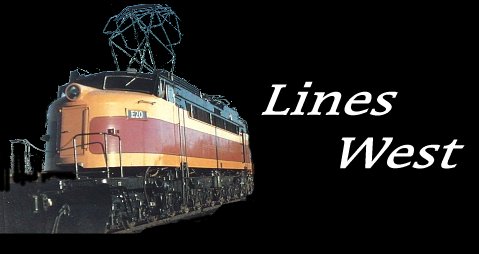
Pictured
is Ed Kieras, relief operator at East Portal Substation,probably July,
1972. East Portal had a lot of activity at night typically, and the machines
there generally ran continuously the whole shift,either generating or regenerating,
although often, between the three 2000kw MG sets,startups and shutdowns
of individual machines would occur during this time, adjusting for load.This
photo was taken about 1 AM.Each substation had a recording ammeter to record
trolley amperage at all times,but every hour the operators still had to
manually record individual machine readings off the "high voltage switchboard",
which was the electric heart of every substation, and that is what Ed is
doing here.I was spending the night at East Portal, but couldn't sleep
because of all the trains, MG set activity, and shutdowns and startups,
so I figured I might as well take some pictures. - Photo and caption-Michael
Sol ©
After
the electrification was shut down on the Rocky Mountain Division the Little
Joes were stripped of usable parts such as traction motors.They were then
lined up and stored in Deer Lodge before being sent to scrappers in Seattle
and Chehalis Washington.
Photo by Michael Sol ©
Prior
to storage in Deer Lodge the E50 has it's pantographs removed. The E50
is now on display in Duluth Minnesota and is especially noteworthy as it
is the original Boxcab, built as the 10200 A/B in 1915.
Photo by Michael Sol ©
A
Little Joe is on the point as an eastbound charges through Missoula Montana
in August of 1971. In less than three years the sun will set on the electrics.
Photo by Michael Sol ©
E20
leads a westbound past the substation in Avery Idaho. Note the motorcycle
that has come along for the ride.
Photo by Michael Sol ©
On
a cold, windy day in January of 1974, SD40-2 #22 charges east through the
University of Montana campus in Missoula. The head end crew is probably
wishing they had a Joe on the point with it's 3000 volt heaters.
Photo by Michael Sol ©
More
snow flies as we see what is likely the X900212 churning through East Portal
Montana. The Milwaukee rebuilt two of it's steam rotaries to work off the
overhead.They were numbered X900212 and the X900215, the 212 based in Avery
while the 215 was in Tacoma. The rotaries had tremendous power when working
on the 3000 volts supplied by the catenary,however they spun the blades
faster than the optimum speed of 150 RPM. Sometimes the substation operators
would lower the voltage for rotary operation,but normally they were powered
by 600 volts supplied by a trailing diesel.
Photo by Ed Kieras, collection of Michael Sol ©
In
April, 1974, Ed Kieras was sitting at his desk in the substation office
listening to a train go by; suddenly he heard an ominous clackety, clackety,
which suggested a boxcar was dragging on the ties. As he reached for his
radio, boom, the MG sets flashed over and there was terrific roar from
the mouth of Tunnel 20. The boxcars were literally form-fitted into the
mouth of the tunnel, destroying the snowshed entirely. The Milwaukee did
not have a big enough wrecker east, and the Avery wrecker had to work from
inside the tunnel west, so the Milwaukee borrowed the Northern Pacific's
big wrecker stationed at Missoula, and that is what is working here, with
East Portal sub in the background. Michael Sol.
Photo by Ed Kieras, collection of Michael Sol ©
So,
as a result, since the end of the electrification was only a few weeks
away, repair of the trolley was not authorized, and the Joes had to drop
their pans just east of East Portal, before raising them inside the tunnel.
Michael Sol
Photo by Ed Kieras, collection of Michael Sol ©
Missoula's
beautiful station looms in the distance in this view from the cab of Little
Joe E21. October,1973.
Photo by Michael Sol ©
One
of the Joes leads an eastbound into Alberton Montana for a crew change.
In the later years of the electrification,the Joes more or less became
helpers,being added to the point of trains at Avery and Harlowton instead
of replacing the diesels. The tremendous horsepower of the Joes, along
with their high speed capabilities helped keep the diesels "wound up" above
transition speed, generally around 24 MPH.Without the Joes for help, the
diesels would fall below this speed and end up lugging their way up the
hill,if they made it at all.
Photo by Michael Sol ©
An
eastbound is ready to go with a Joe on the point while a westbound works
the yard with some Coast Division GE's.
Does
it get any better than this?
Photo © Michael Sol
Close this window to return to the homepage.